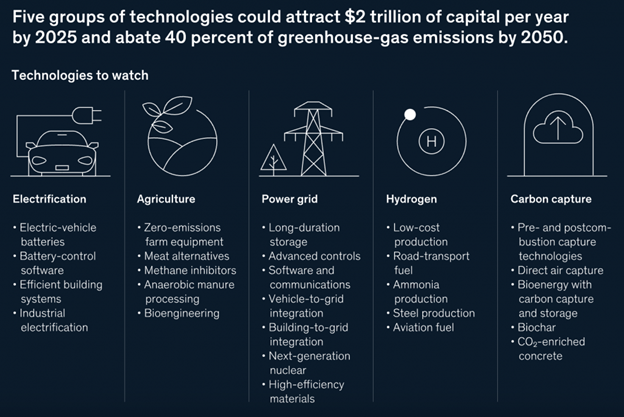According to an analysis by scientists from NOAA’s National Centers for Environmental Information (NCEI), 2023 was the planet’s warmest year on record. Along with the historic heat, Antarctic Sea ice coverage dropped to a record low in 2023.

Other scientific organizations, including NASA, the Copernicus Climate Change Service, and the UK Met Office have conducted separate, but similar analyses, also ranking 2023 as the warmest year on record. As country governments have become increasingly concerned, companies have come under regulatory pressure from the European Union (EU) and the US to address sustainability. This has led to companies focusing their attention on innovative technology solutions to help them with their sustainability initiatives. In addition, consumers are becoming more environmentally conscious, and are increasingly choosing products and services from companies that prioritize sustainability. Technology can help businesses meet this growing demand by offering sustainable solutions. While companies may face challenges in meeting regulatory pressure and consumer demand, sustainable practices can often lead to cost savings, such as reducing energy consumption, waste, and water usage. Companies that are seen as leaders in sustainability can gain a competitive advantage and differentiate themselves from their competitors by showcasing their commitment to sustainability. Finally, climate change poses significant risks to companies, such as supply chain disruptions, reputational damage, and financial losses. Technology can help companies mitigate these risks by providing tools for climate modeling, risk assessment, and adaptation planning.
Five Climate Technology Challenges Leading up to 2025 and 2050

Specific examples of how technology can be used for sustainability include:
- Renewable energy: Transitioning to renewable energy is one of the most significant ways technology can advance sustainability in companies. Solar, wind, and hydropower technologies transform how companies source their energy, significantly reducing reliance on fossil fuels and reducing carbon emissions. Solar panels and wind turbines have become increasingly efficient and affordable, enabling companies to utilize clean energy for their operations. During periods of low energy generation, advancements in energy storage solutions, such as batteries and smart grids, ensure that renewable energy can be reliably integrated into the power system.
- Energy efficiency: Technology can be used to optimize energy usage in buildings, factories, and data centers, reducing energy consumption and costs.
- Waste management: Technology can help companies track and reduce waste, improve recycling rates, and develop innovative waste management solutions.
- Supply chain management: Technology can be used to trace the environmental impact of products and materials throughout the supply chain, enabling companies to make more sustainable sourcing decisions.
- Carbon accounting: Technology can help companies measure and report their carbon emissions, allowing them to set and track progress towards sustainability goals.
Technology plays a pivotal role in mitigating the impact of climate change and aiding in regeneration efforts.
Carbon Capture and Storage
A number of companies are investing in carbon capture and storage (CCS) technology to reduce their carbon footprint and contribute to climate change mitigation. CCS is the process of capturing carbon dioxide (CO2), either to prevent it from entering the atmosphere or to directly remove it from the atmosphere, and safely and securely storing that CO2 thousands of feet below the surface.
Chevron and Exxon are targeting $10 billion and more than $20 billion, respectively, of spending on emissions-reducing technologies that include CCS in major projects under development along the Gulf Coast. Over the last couple of years, Exxon has entered agreements to capture carbon emissions from ammonia and fertilizer producer CF Industries and steelmaker Nucor, both in Louisiana, and industrial gas producer Linde in Beaumont, Texas. Exxon is targeting a startup date for a CCS at CF Industries in the first half of 2025.
Geoengineering
Geoengineering, also known as climate engineering, is a group of emerging technologies that aim to intentionally manipulate the Earth’s climate to help combat climate change. While geoengineering offers potential solutions to climate change, it is important to note that it is a complex and controversial subject. There are concerns about unintended consequences, ethical implications, and the potential for reliance on geoengineering to delay or avoid necessary emissions reductions. Geoengineering can be divided into two main categories:
- Carbon dioxide removal (CDR): This process involves removing CO2 from the atmosphere, which is the root cause of climate change. Techniques include planting trees, enhancing natural carbon sinks like oceans, and directly capturing carbon from the air.
- Solar radiation management (SRM): This approach involves reflecting a small amount of sunlight back into space to cool the planet. SRM does not address the root cause of climate change.
Biotechnology
Biotechnology offers innovative solutions to many sustainability challenges. Advances in biotechnology are enabling the production of sustainable materials, fuels, and food. Examples include:
- Biochar production: Biochar involves making charcoal from plant residues and animal waste. The charcoal can be mixed into soil as a fertilizer, which can increase the rate at which plants absorb CO2 from the atmosphere and store it in their tissues, effectively removing it from the environment.
- Cloud brightening: This approach is a geoengineering technique that aims to cool the Earth by increasing the reflectivity of clouds. This involves introducing tiny, reflective particles into the atmosphere, which can make clouds brighter and reflect more sunlight back into space.
Nanotechnology
Nanotechnology offers promising solutions to global sustainability challenges, such as energy storage, water purification, agriculture, environmental remediation, and healthcare. By manipulating matter at the atomic and molecular scale, nanomaterials can improve efficiency, reduce waste, and minimize environmental impact. However, it is important to address potential risks and challenges, such as toxicity, ethical considerations, and regulatory frameworks.
Dow Chemical is using nanotechnology in several applications. Dow produces nanofiltration membranes for water purification, allowing for more efficient and effective removal of contaminants. In addition, the company uses nanoparticles to create coatings with enhanced durability, corrosion resistance, and self-cleaning properties.
Conclusion and Recommendations
As global temperatures continue to rise and environmental concerns increase, companies are turning to innovative technologies to address sustainability challenges. Technology is playing a crucial role in helping companies reduce their environmental impact while meeting regulatory requirements and consumer demands. Emerging technologies, such as carbon capture and storage, geoengineering, biotechnology, and nanotechnology, are offering promising solutions for mitigating climate change and promoting sustainable practices across industries. To find out more about how innovative technologies could contribute to your company’s abatement plans, contact Canopy Edge for an initial consultation.


